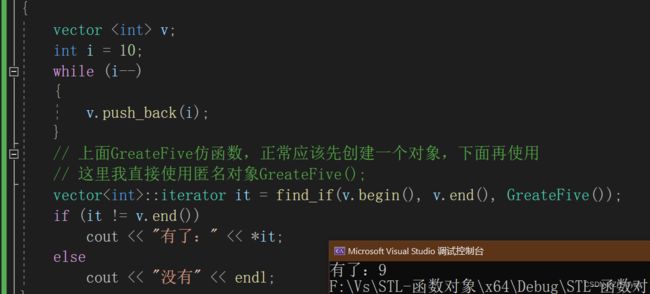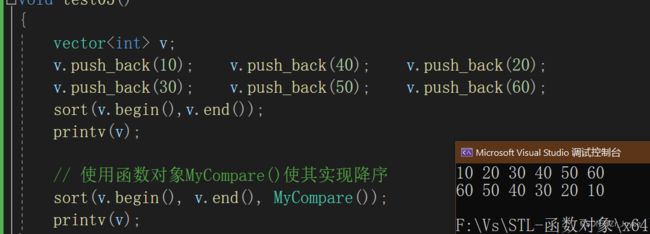STL-函数对象
目录
一、函数对象
1、基本概念
2、使用
二、谓词
1、基本概念
2、一元谓词
3、二元谓词
三、内建函数对象
1、基本概念
2、算数仿函数
3、关系仿函数
4、逻辑仿函数
一、函数对象
1、基本概念
概念:
①重载函数调用操作符的类,其对象常称为函数对象
②函数对象使用重载的()时,行为类似函数调用,也叫仿函数
本质:
函数对象(仿函数)本身是一个类,并非一个函数
2、使用
特点:
①函数对象在使用时 ,可以像普通函数那样调用,可以有参数与返回值
②函数对象超出普通函数的概念,可以有自己的状态
③函数对象可以作为参数传递
测试:
①仿函数MyAdd
class MyAdd
{
public:
int operator()(int x,int y)
{
return x + y;
}
};test函数,直接调用普通函数那样调用
void test01()
{
MyAdd myadd;
cout << myadd(1, 5) << endl;
}②仿函数MyPrint,内有属性count来记录自己状态
class MyPrint
{
public:
MyPrint()
{
this->count = 0; // 初始化为0
}
void operator()(string s)
{
cout << s << endl;
this->count++;
}
int count; // 记录自己状态
};test函数,调用多次MyPrint函数
void test02()
{
MyPrint myprint;
myprint("Jocye is my ba"); myprint("Jocye is my ba");
myprint("Jocye is my ba"); myprint("Jocye is my ba");
cout << myprint.count << endl;
}③doPrint函数
void doPrint(MyPrint& mp,string s) // mp作为一个参数进行传递
{
mp(s); // 同时还能使用自身来打印s
}test函数,我们调用doPrint函数
void test03()
{
MyPrint myprint;
doPrint(myprint, "Hello my");
}二、谓词
1、基本概念
概念:返回bool类型的仿函数称为谓词
如果operator()接受一个参数,称为一元谓词
如果operator()接受两个参数,称为二元谓词
2、一元谓词
void test04()
{
vector v;
int i = 10;
while (i--)
{
v.push_back(i);
}
// 上面GreateFive仿函数,正常应该先创建一个对象,下面再使用
// 这里我直接使用匿名对象GreateFive();
vector::iterator it = find_if(v.begin(), v.end(), GreateFive());
if (it != v.end())
cout << "有了:" << *it;
else
cout << "没有" << endl;
}
int main // find_if(起始迭代器,终止迭代器,仿函数);
//返回的也是个迭代器,找到返回所在位置迭代器,否则返回end();
仿函数GreateFive(),大于5返回真
class GreateFive
{
public:
bool operator()(int val)
{
return val > 5;
}
};由于是从9加进去,加到1,因此第一个数9就满足,返回
3、二元谓词
void test05()
{
vector v;
v.push_back(10); v.push_back(40); v.push_back(20);
v.push_back(30); v.push_back(50); v.push_back(60);
sort(v.begin(),v.end());
printv(v);
// 使用函数对象MyCompare()使其实现降序
sort(v.begin(), v.end(), MyCompare());
printv(v);
} 二元谓词MyCompare
class MyCompare
{
public:
bool operator()(int x, int y) // 二元谓词,2个参数
{
return x > y;
}
};打印函数printv()
// 二元谓词
void printv(vector& v)
{
for (vector::iterator it = v.begin(); it != v.end(); it++)
{
cout << *it << " ";
}
cout << endl;
} 三、内建函数对象
1、基本概念
首先,STL内建了一些函数对象(仿函数)
分类:算数仿函数、关系仿函数、逻辑仿函数
使用:
①这些仿函数所产生的对象,用法与一般函数完全相同
②使用内建函数对象,需要引用头文件#include
2、算数仿函数
功能:实现四则运算
函数:
/*算数仿函数
template T plus 加法仿函数
template T minus 减法
template T multiplies乘法
template T divides 除法
template T modulus 取模
template T negate 取反
*/ 其中negate是一元运算,其他都是二元运算
测试:
①取反仿函数
void test06()
{
negate n;
cout << n(50) << endl;
} ②加法仿函数
void test07()
{
plus p; // 默认传同种数据类型
cout << p(5,10) << endl;
} 3、关系仿函数
功能:实现关系对比
函数:
/*关系仿函数
template bool equal_to 等于
template bool not_equal_to 不等于
template bool greater 大于
template bool greater_equal 大于等于
template bool less 小于
template bool less_equal 小于等于
*/ 测试:
在此之前,我们创建vector容器里面存入数据,如果想让数据降序排序,需要自己实现仿函数
void test08()
{
vector v;
v.push_back(10); v.push_back(40); v.push_back(20);
v.push_back(30); v.push_back(50); v.push_back(60);
sort(v.begin(), v.end());
printv(v);
// 使用函数对象MyCompare()使其实现降序
sort(v.begin(), v.end(), MyCompare());
printv(v);
} 此时,我们使用内建函数greater
// 使用内建函数对象
sort(v.begin(), v.end(), greater()); 而若是想比较其他的数据,如float,我们只需要修改为greater
同时,greater是比较常用的
我们打开sort排序源码
可以发现,如果要重载,上面有3个参数,而下面默认的只有2个参数(起始和终止区间)
 而默认的2个参数的,调用的是less<>,因此默认使用升序排序从小到大
而默认的2个参数的,调用的是less<>,因此默认使用升序排序从小到大
4、逻辑仿函数
功能:实现逻辑运算
函数:
/*逻辑仿函数
template bool logical_and 逻辑与,同时为真才真,其余为假
template bool logical_or 逻辑或,同时为假才假,其余为真
template bool logical_not 逻辑非,取反操作
*/ 测试:创建容器v和容器v2,v中存入true与false的数据,取反后存入v2
void test09()
{
vector v;
v.push_back(true); v.push_back(false); v.push_back(true);
v.push_back(true); v.push_back(false);
printv(v);
// 取反,放入另一个容器
vector v2;
v2.resize(v.size()); // 指定v2的size为v的size
transform(v.begin(), v.end(), v2.begin(),logical_not());
//搬运算法 起始 终止 目标的起始 逻辑非
printv(v2);
} 









